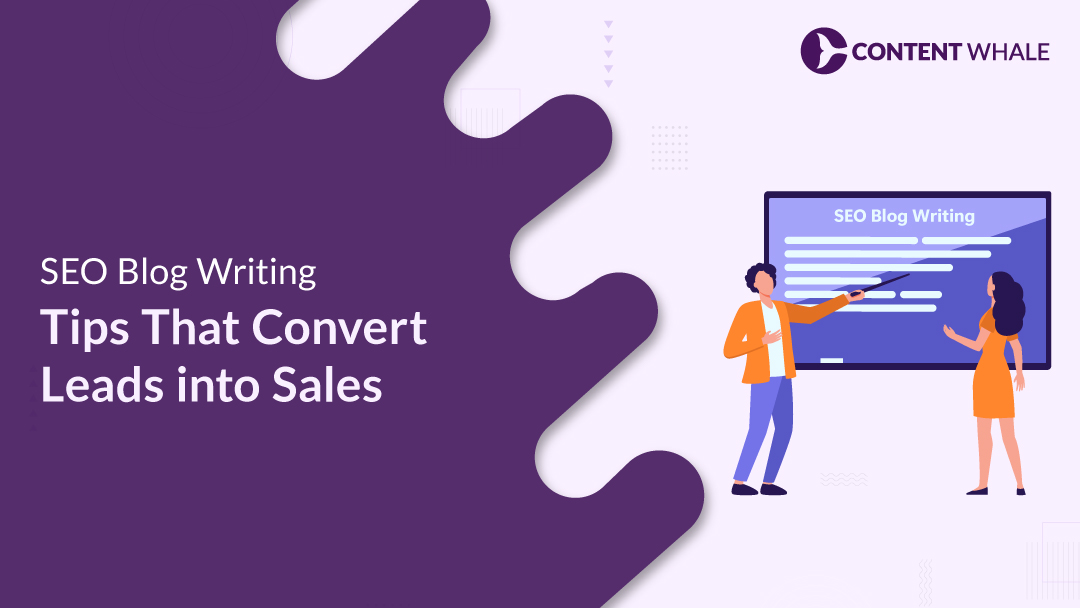When it comes to SEO blog writing, the ultimate goal is to not only drive traffic but to convert leads into sales. To achieve this, the blog content must be crafted with both search engine visibility and audience engagement in mind. By aligning your SEO strategies with conversion goals, you can capture attention and guide potential customers down the sales funnel.
In this blog, we’ll explore key SEO blog writing tips that help you move from simply generating traffic to creating content that converts.
From keyword optimization and well-placed calls-to-action (CTAs) to writing compelling content that keeps readers engaged, these actionable insights will help transform your blog into a powerful tool for lead generation and sales.
1. The Power of SEO in Driving Sales
SEO goes beyond generating traffic; it’s about attracting visitors who are ready to make a purchase. Here’s how you can use SEO to drive sales:
A) Focus on Buyer Intent Keywords
- Keywords such as “buy,” “best,” or “discount” often signal transactional intent. These are the visitors who are closer to making a purchasing decision.
- Incorporating buyer intent keywords helps in attracting leads who are more likely to convert.
B) Align Content with User Intent
- Different types of user intent (informational, commercial, transactional) require different SEO strategies.
- Informational content like guides can bring in potential leads, while transactional content nudges visitors to act.
C) Boost Organic Traffic and Lead Quality
- By optimizing your content with high-conversion keywords, you’re not just increasing traffic but also improving the quality of visitors.
- More targeted visitors lead to higher conversion rates, making SEO a direct driver for sales.
2. Keyword Optimization for Lead Conversion
To turn blog visitors into leads, keyword optimization plays a crucial role. Here’s how to optimize your keywords for better conversions:
A) Use Long-Tail Keywords
- Long-tail keywords are highly specific phrases like “best SEO blog writing tips for conversions.” These keywords often target users who are closer to making a decision.
- Tools like Google Keyword Planner and Ahrefs can help you find these high-intent keywords that attract leads ready to convert.
B) Strategic Keyword Placement
Place your primary keywords in key locations:
- Title: This is the first thing search engines and readers see, so make sure it’s keyword-optimized.
- Headers: Include LSI keywords in H2 and H3 tags for better ranking and clarity.
- Meta description: A well-crafted meta description with your keywords can increase click-through rates.
- Body text: Naturally integrate keywords throughout the blog without overstuffing. The goal is smooth readability.
C) Focus on Semantic Keywords
- Use related terms or LSI keywords (like “blog SEO best practices” or “lead generation strategies”) to give search engines a better understanding of your content’s context.
Tips for Natural Integration:
- Avoid keyword stuffing. Write for humans, not just search engines.
- Keep the flow natural, allowing keywords to fit seamlessly within the content while improving relevance.
3. Writing Engaging Blog Content for Conversions
The way you structure and write your blog content plays a huge role in converting readers into leads. Here are some strategies to make your content more engaging:
A) Capture Attention with Compelling Introductions
- The introduction should immediately grab attention, giving readers a reason to continue. Pose a question or address a common pain point that resonates with your target audience.
B) Structure for Readability
- Use subheadings, bullet points, and short paragraphs to make the content scannable. This helps keep the reader engaged.
- Break up the text with relevant visuals like charts or infographics when applicable.
C) Add Value with Actionable Content
- Offer step-by-step guides or how-to instructions that readers can implement immediately. This builds trust and establishes authority.
D) Incorporate Storytelling
- Storytelling can make your content relatable and inspire action. Use examples, case studies, or personal stories to connect with your audience on a deeper level.
4. Effective Use of Calls-to-Action (CTAs)
A well-placed and well-written call-to-action (CTA) can significantly increase conversions. Here’s how to use them effectively in your blog:
A) Craft Clear and Direct CTAs
- Your CTA should leave no room for ambiguity. Use action-driven words like “Get Started,” “Sign Up Now,” or “Download Free Guide” to prompt immediate action. Make sure it’s aligned with the reader’s stage in the buying journey.
B) Placement of CTAs
Place CTAs in high-visibility areas:
- Within the content: A natural CTA that fits within a sentence can catch the reader’s attention while they’re still engaged.
- At the end of the blog post: This is the perfect spot to encourage readers to take the next step.
- Sidebar or pop-up: Use sparingly, but these can work well for capturing attention when a reader scrolls or is about to exit.
C) Test Different Formats
Experiment with various formats:
- Buttons: Bright, clickable buttons draw attention.
- Inline text links: Subtle yet effective when embedded in the content.
- Banners: Visual banners with clear CTAs can encourage action, especially for time-sensitive offers.
D) Create Urgency
- Use time-sensitive offers or limited availability (e.g., “Only 2 days left!”) to create urgency, motivating users to act quickly.
5. SEO Copywriting Best Practices for Lead Generation
SEO copywriting is a powerful tool for turning readers into leads. To make the most of it, follow these practices:
A) Write with the Reader’s Pain Points in Mind
- Address pain points directly. Use emotional triggers to show readers how your solution will solve their problems, guiding them to take action.
B) Use Persuasive Language
- Incorporate power words such as “exclusive,” “proven,” or “results” to create a sense of urgency or excitement.
- Keep your tone friendly and helpful, ensuring the language is motivating but not overly salesy.
C) Balance SEO and Readability
- Ensure your blog is optimized with keywords but remains easy to read. Avoid over-optimizing; instead, focus on natural integration of primary keywords and LSI keywords like “content marketing” and “conversion-focused content.”
D) Leverage User Intent
- Content should align with user intent—whether informational, transactional, or navigational. Understanding this helps create a more targeted approach, leading to higher conversions.
6. Optimizing Blogs for Mobile Users and Page Speed
With more users accessing content via mobile devices, mobile optimization has become critical for blog conversion. Here’s how to ensure your blog is optimized:
A) Make Your Blog Mobile-Friendly
- Ensure your blog has a responsive design, so it adjusts seamlessly to different screen sizes.
- Keep your paragraphs short and use larger fonts for easy reading on smaller screens.
- Avoid large blocks of text. Use bullet points, headings, and whitespace to break up the content.
B) Improve Page Load Speed
- A fast-loading blog keeps visitors engaged. Pages that take more than three seconds to load often lead to higher bounce rates.
- Compress images, minify CSS and JavaScript, and use browser caching to improve your page speed. Tools like Google PageSpeed Insights can help assess and enhance load times.
C) Simplify Navigation for Mobile Users
- Make sure navigation menus are easy to find and use. Include a clear CTA that’s easy to tap on mobile devices, like a button placed within thumb’s reach.
| # | Step | Description | Impact |
| 1 | Use Responsive Design | Adapt blog layout to all screen sizes. | Enhances mobile user experience. |
| 2 | Compress Images | Use WebP and lazy loading for faster image loading. | Reduces page load time on mobile. |
| 3 | Minify Code | Minimize HTML, CSS, and JavaScript files. | Speeds up overall load times. |
| 4 | Implement Caching | Store data temporarily for faster delivery. | Improves server response time. |
| 5 | Prioritize Key Content | Load above-the-fold content first. | Ensures critical content loads faster for mobile users. |
| 6 | Use a CDN | Distribute content across multiple servers worldwide. | Reduces latency and improves load speed globally. |
| 7 | Reduce HTTP Requests | Combine multiple files into fewer requests. | Lowers server load and increases speed. |
7. Measuring Success: Analytics for Conversion-Focused Blogs
Tracking the right metrics is essential to measure the effectiveness of your conversion-focused blogs. Here’s what to focus on:
A) Key Metrics to Track
- Conversion Rate: This is the percentage of visitors who take the desired action, such as signing up or making a purchase.
- Bounce Rate: A high bounce rate indicates that visitors are leaving your page without engaging. Low bounce rates usually signal that readers find your content valuable.
- Time on Page: A higher time on page suggests that visitors are reading through your content and engaging with it.
B) Tools to Use
- Google Analytics: Track user behavior, including which posts lead to the most conversions.
- Hotjar: Analyze heatmaps and scroll depth to see how far readers get in your blog and where they drop off.
C) A/B Testing
- Regularly A/B test elements like headlines, CTAs, and blog layouts to find what drives the most conversions.
Conclusion
Incorporating SEO blog writing tips into your content strategy is key to converting leads into sales. By focusing on keyword optimization, crafting engaging content, strategically placing CTAs, and ensuring your blog is mobile-friendly, you create a seamless user experience that encourages action. Consistent monitoring of conversion metrics allows you to fine-tune your strategy, ensuring ongoing improvements.
Remember, SEO is not a one-time effort. Continuously optimizing your content to align with both search engine algorithms and user behavior will help boost your conversions. Implement these tips, and watch your blogs transform from simple traffic drivers to effective tools for lead generation and sales growth.
At Content Whale, we specialize in crafting SEO-optimized content that not only drives traffic but also converts leads into sales. With a proven track record in SEO blog writing, keyword optimization, and conversion-focused strategies, we help businesses increase their visibility and engage their audience effectively.
Let us help you create content that converts—boost your lead generation and sales today with our expert writing services!
FAQs
1. What are the best keywords for SEO blog writing?
Look for long-tail keywords with high buyer intent. Tools like Google Keyword Planner or SEMrush can help you find relevant, high-conversion keywords.
2. How can I increase the conversion rate of my blog?
Focus on crafting compelling CTAs, optimizing for mobile users, and ensuring that your content directly addresses user pain points. Regularly track and optimize through A/B testing.
3. What is the ideal CTA placement in a blog post?
CTAs work best when placed within the content, at the end of the post, or as a sidebar widget. The placement should feel natural and align with the reader’s journey.
4. How do SEO and lead generation work together?
SEO brings in targeted traffic by optimizing content for search engines, while lead generation techniques like CTAs and conversion-focused content help convert those visitors into leads.
5. Why is page speed important for blog conversions?
A fast-loading blog improves user experience, reduces bounce rates, and ensures readers stay on the page long enough to engage and convert.





